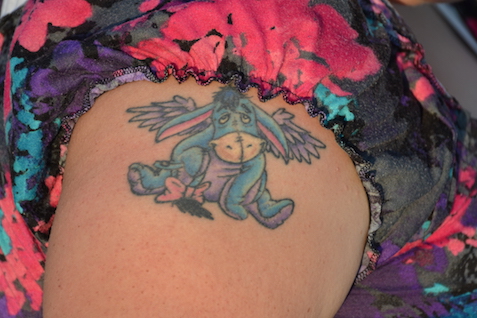Newsletter Issue 68 - October 2014
In this issue:
Supreme Court protects cable
Copyright and tattoo art
Death of the software patent
Ask Dr. Copyright ...
Dear Doc:
Since you wrote about Aereo, that company with the millions of TV
antennas that was going to free us from the tyranny of Comcast,
Verizon, Time-Warner, Cox, and all of the other blood-sucking video
vampires, and the fact that Aereo lost big-time in the Supreme
Court, we have been waiting for the next chapter. So what gives?
Signed,
Walter White and Tony Soprano
Dear Walt and Tony:
Fear not! The Aereo saga continues, and it's gotten even stranger
since those six Honorable Justices of the Supreme Court shut down
the service in June.
You may remember (and if not, you can read the Doc's June 28th
column) that Aereo argued that it was just a remote antenna and DVR,
not a cable service, and so, it did not have to pay royalties to
television broadcasters. That made sense to judges in New York, but
in Washington, DC, not so much. The Supreme Court reasoned that
technological differences make no difference. If Aereo's service
looked like the kind of cable service that Congress wanted to
restrict, then, by gum, it was legally the same (never mind those
millions of tiny antennas, tuners, hard drives, and the fact that
you can legally time and space shift broadcast television under the
Sony Betamax ruling by an earlier Supreme Court.)
As the Court said, "why should any of these technological
differences matter? They concern the behind-the-scenes way in which
Aereo delivers television programming to its viewers' screens. ...
Why would a subscriber who wishes to watch a television show care
much whether images and sounds are delivered to his screen via a
large multisubscriber antenna or one small dedicated antenna,
whether they arrive instantaneously or after a few seconds' delay,
or whether they are transmitted directly or after a personal copy is
made?"
Okey-dokey, said Aereo...if that's what the Court says, then we'll
just be a cable company, pay royalties to the broadcasters, and pass
those fees on to our subscribers. After all, competition in the
market is what the good ol' USofA is all about, right? Now, you'd
think that the TV guys would be pleased to have more money, and that
would be the end of it, but no, here's where the story gets even
more bizarre.
Aereo's Position: The Supremes said that we walk like a duck, and
quack like a duck, so we are legally a duck. We now agree, so we are
going to use the compulsory license provisions of the Copyright Act
to allow us to retransmit over-the-air programs to our customers. We
will, of course, pay for that right as the law requires. Done and
done.
The TV Guys: No so fast, Aereo. You're NOT a cable TV company, and
you can't use the law that the Supreme Court says you violated to
stay in business by paying us. You have to stop. You can't show our
programs. Not in real time, and not even by time-shifting. We demand
an injunction from the trial court. Now!
The District Court considered the issues carefully. Judge Allison
Nathan then issued a 17 page order effectively shutting down Aereo.
Why, you ask?
Well, to put it bluntly, it's not good enough even if Aero agrees
with the Supreme Court, and offers to pay. Judge Nathan reasoned
that "Aereo's argument suffers from the fallacy that simply because
an entity performs copyrighted works in a way similar to cable
systems it must then be deemed a cable system for all other purposes
of the Copyright Act." And, unfortunately for Aereo, an earlier
decision of the Second Circuit Court of Appeals had already
determined that Congress never intended that Internet transmissions
of video should be called cable television for purposes of the
Copyright Act.
WPIX, Inc. v. ivi, Inc. (Perhaps the Supremes didn't
read that one).
So, Judge Nathan issued an order prohibiting Aereo from transmitting
any TV program on its system while that program was being broadcast
(leaving, for the moment, the question of whether Aereo's DVR
function could remain online.)
Aereo, like other innovators such as Uber, Lyft, and AirBnb, is
faced with laws and judicial interpretations that look squarely
backward, while their business models try to look to the future. So
there you have it (or rather, you don't, and won't anytime soon.)
The Doc suggests that you call your cable company for service. That
way, at least you'll be home between November 1st and 15th between
the hours of 6am and 9pm, and that will keep you out of trouble.
Have a question about some intellectual property dilemma? The
attorneys at LW&H actually like to think about such things (even
though it sometimes makes their heads hurt.) Give them a call.
Until next month (or not)... Don't stop believin'.
The "Doc"
Fixed in a Tangible Medium ... Tattoo Art

Now that sporting a tattoo has gone mainstream, it would
only stand to reason - - given that tattoos are creative expressions
fixed in a tangible medium (skin) - - that tattoo artists seek
protection of their designs under copyright law. To date, few
copyright cases involving tattoos have been filed but we've learned
that video game companies, in particular, are not taking chances.
Here's some background.
First, why you may ask is a tattoo deserving of copyright
protection?
Section 102 of the Copyright Act provides protection
for "original works of authorship fixed in any tangible medium of
expression." "Works of authorship" include a number of categories,
including pictorial and graphic works. There should be little
controversy that a tattoo design is equivalent to a graphic or
pictorial work and that skin is a tangible medium of expression.
The question of determining "originality" would be the same as for
any graphic work. But once created, who owns the image? The
customer or the artist? Copyright law would assign ownership rights
to the artist unless there is a license or assignment of the rights
to the customer. There are other interesting issues. Could
photographs of the wearer in which the tattoos are visible be
actionable copyright infringements? What about video games? NBA
stars, for example, adorn themselves with tattoos. Do video game
companies need a license to portray the stars and their tattoos and,
if so, from whom do they obtain licenses, the wearer or the
artist?
In 2011, in perhaps the first lawsuit of its kind, Victor Whitmill,
a tattoo artist -- most notable for creating the Maori inspired
tattoo on the side of Mike Tysons's face -- sued Warner Brothers
Entertainment in an attempt to stop the release of the movie
"Hangover Part II" in which one of the characters was tattooed in
identical manner to that of Mike Tyson. Whitmill claimed copyright
infringement resulting from the film's promotional activities
showing the tattoo, demanded that release of the movie be stopped,
and other costs and damages.
The judge agreed that Mr. Whitmill had "lost control over the image
he created" and that Whitmill had a legitimate copyright claim in
his tattoo design, Yet, the court refused to grant Mr. Whitmill's
request for a preliminary injunction ruling that "the public
interest does favor protecting the thousands of other business
people in the country as well as Warner Brothers" connected to the
film and its promotion.
The parties eventually settle
Though not the final word on the matter, the court's decision sets
the stage d.for similar type actions by those seeking to protect tattoo
designs.
As result of this lawsuit -- and good business sense -- certain
media companies and sport groups, according to the
Wall Street
Journal, weren't taking chances. The NFL players Association was
urging athletes to obtain licenses for their body art and Electronic
Arts (EA) reported that for its latest video game "Madden NFL 15",
that it scanned images of tattoos only from after getting legal
authorization from the artist who drew them. Apparently, tattoo
artists are more than willing to sign releases when presented to
them by sports athletes.
If you'd like to learn more about the legal basis for claiming
copyright protection in tattoo art, don't hesitate to call the
lawyers at Lipton, Weinberger & Husick.
Another One Bites the Dust! 
In the not-so-slow death spiral of software patents in light of
the Supreme Court's recent decision in Alice v CLS Bank, another
trial court has determined that a patent for software should not
have been issued because the software addressed by the patent is not
the kind of invention eligible for patenting.
In the case of Amdocs v Openet Telecom, the Federal district court
considered whether inventions directed to software for reporting
usage of network devices on a computer network could be patentable.
The court applied the two-part test of Alice v CLS Bank: first,
does the challenged patent claim address an abstract idea; second,
does the claim include 'something more' to transform the abstract
idea into something that is patent-eligible. The court's answer to
the first question was 'yes' and to the second question was 'no,'
rendering the patents unenforceable.
The claims in question addressed a purely software product that does
nothing outside of a computer. What the software product does
inside the computer did not seem to be of much interest to the
court. If the Amdocs decision becomes the norm, then patents for
software will be only a dusty footnote, like the passenger pigeon.

